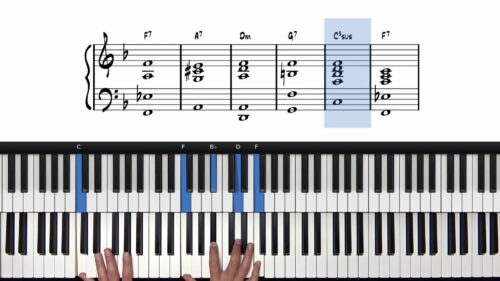Blues Turnarounds: Simple to Advanced
In this lesson we explore a variety of blues turnaround options that we can use at the end of a 12-bar blues progression. The primary role of a turnaround is to create a smooth and convincing transition back to the beginning of the form, preparing us for the next chorus.
In this lesson, we’ll cover a range of turnarounds, from simple to sophisticated variations. By the end of this lesson, you’ll have a solid understanding of how to apply different turnaround options in your playing.
Basic Turnaround Example
We start with a simple turnaround that begins in bar 11 of the 12-bar blues form. The key idea here is the descending third intervals in the right hand mirrored by the descending single note line in the left hand:

An important chord here is the C/G which feels like we are almost back at the tonic chord, but not quite. This is followed by a G7 at the end of bar 12 which sets up the V to I transition to start the form again.
Once we’ve mastered the basic turnaround, we can experiment with different variations of the G7 chord such as a G7#5 to add tension and dissonance, creating a stronger sense of resolution back to C7 at the top of the form.
Walk-Up and Walk-Down Turnarounds
We then explore slightly more complex turnarounds that use both a walk-up and walk-down sequence of chords. Starting from C7, we can move through the chords C7 to C/E to F7 to Fdim7, and then to the same sequence that we covered in the previous example (C/G and G7#5):

This creates a feeling of forward momentum as the chords rise or fall, leading naturally back to the tonic. You can also experiment with grace notes or adding octaves for extra depth. This progression introduces the chromatic movement of F to F#dim7 to C/G which can also be approached with blues scale licks and embellishments.
Bluesy Turnaround with the Minor Blues Scale
To add a gritty, more “bluesy” feel to our turnarounds, we use elements of the C minor blues scale. Here we start with a C7 chord and incorporate the same chord progression as the previous example, but voiced with 10th intervals in the left hand:

This style emphasises the raw, emotive quality of blues music and fits well with more aggressive playing styles. As always, try different fingerings to find what works best for your hands.
Practice Tips
-
Start Slow: Focus on becoming comfortable with the hand movements and fingering before playing at full speed.
-
Walk-Up vs. Walk-Down: Practice both variations to see how they alter the feel of your turnaround. Notice that both end in the same place (C/G).
-
Apply Across Keys: Once you're comfortable in C major, transpose these turnarounds into other keys to deepen your understanding of the harmonic movements.






